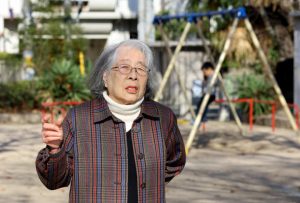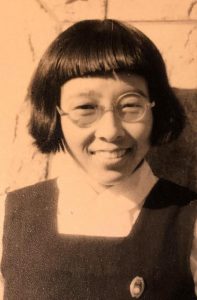Survivors’ Stories: Junko Kayashige, 83, Nishi Ward, Hiroshima
Jan. 23, 2023
Lost two sisters of 10 family members
Keep on painting with anger toward nuclear weapons
by Hiromi Morita, Staff Writer
Junko Kayashige (née Yoshimura), a former art teacher, has shared her accounts and the realities of the atomic bombing at home and abroad. For this purpose, she traveled to the United States in 1988 in conjunction with the Special Session of the United Nations General Assembly on Disarmament. She is now 83 and still active as an artist. Although she does not directly depict the atomic bombing in her paintings, her anger toward nuclear weapons is clearly visible in her artwork.
Ms. Kayashige was exposed to the atomic bomb when she was six years old. During the war at a time when it was considered the more children a family had, the better, she had one elder brother, five elder sisters and two younger sisters. However, as her eldest sister died young, she lived with her parents, who operated a needle factory in Yokogawa-cho (now part of Nishi Ward, Hiroshima), and her siblings. There were 10 people in her family.
On the morning of August 6, 1945, her elder brother was in Yamaguchi having been drafted by the army, while her father was in Okayama on business. Her third elder sister Hiroko, then 14, who was a student at Shintoku Girls’ High School, was mobilized for war efforts in the city center. Her mother was at her cousin’s home in Itsukaichi (now part of Saeki Ward). Her fourth elder sister Michiko, then 12, wanted to accompany her mother, but her mother brought only her youngest sister who was a baby. After seeing her mother off, Michiko went out to buy some ice by bicycle.
Ms. Kayashige went to her uncle’s home nearby with her younger sister Tomie, then 3. While playing with her cousins, she heard the sound of a plane from above. Probably the moment she looked up at the sky standing in front of the window, the atomic bomb must have exploded. She was about 1.5 kilometers from the hypocenter. When she came to after the blast, she was standing on the earthen ground with no tatami mat floors or floorboards.
Her uncle’s house was strong enough to avoid collapse. When she went outside, however, she found all the other houses around her uncle’s house had been flattened. Ms. Kayashige didn’t know what to do and ran alone from the scene. She walked over the broken roof tiles and headed westward. Although she suffered severe burns on her right arm, face and neck, she walked being swept along with the crowd.
On the way, she met a relative, who had come from Itsukaichi to see what happened in the city, and was brought to a relief station in Koi (now part of Nishi Ward) to receive first-aid treatment.
She doesn’t remember how she got to her cousin’s house in Itsukaichi, but she was reunited with her mother there. The burns on her face were so severe that pus continued to come out of her right eye for some time.
All ten members of her family, including her parents and siblings who entered the city center at the time of and after the atomic bombing, were exposed to radiation. Hiroko, who suffered severe burns on her back, died soon after, while Michiko, who went out to buy ice, is still considered missing.
When the war ended, Ms. Kayashige was in Itsukaichi. Adults cried during the broadcast of the Emperor’s announcement of Japan’s surrender. Ms. Kayashige, however, recalls by saying, “I was relieved to know we will not have to experience hardship anymore.” After the war, the remaining family members lived together in a shack her father built in Yokogawa, and began to rebuild their lives.
As time passed, Ms. Kayashige, who loved painting, went on to art college in Tokyo and became a teacher at Hiroshima City Junior High School. The scars from the burns she suffered have never gone away and she had avoided even thinking about the atomic bombing.
It was in the ninth year after she became a teacher when a turning point arrived. As part of a peace education program during summer vacation, she gave her students homework to write about the A-bomb experiences of their families. She asked herself, “I told my students to write about the atomic bombing. Then, is it fair for me to completely shut out my experience?” She first wrote of her own experience in her memoirs. After this, she started sharing her experiences with others when requested. She says, “This is all from my strong determination that no one should suffer the same fate.”
Ms. Kayashige is now concerned about the current world situation where many lives are lost in Russia’s invasion of Ukraine and military expansion is advancing in some countries as if being inspired by Russia’s invasion. At the same time, she remembers special procurement during the Korean War. Despite the fact that so many people lost their lives during World War II, Japan enjoyed an economic boom during the Korean War. I’ve never forgotten that I was so shocked when even my father, who had been overwhelmed with grief over the death of his beloved two daughters, rejoiced and said, “This will boost Japan’s economy.” We should not forget our collective imagination about the loss of human life nor be swayed by the thought of immediate profit. I will keep on painting to convey this important message to young people.”
(Originally published on January 23, 2023)









